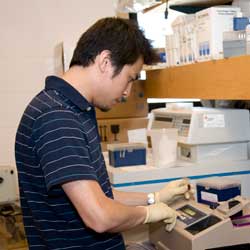 |
|||||||||||||||||
|
|||||||||||||||||
|
Research
We use both mammalian systems and model organisms, and focus on developing new systems-based approaches to understand phagocytosis and innate immunity. Our ultimate aim is to generate and test novel hypotheses concerning the host-pathogen interaction and the role of phagocytosis in development and host defense. The use of computational modelling to understand the cell biology and evolutionary origins of the phagosome
The role of phagocytosis in innate immune sensing We are interested in defining the role of phagocytic receptors and opsonins in regulating innate immune sensing by pattern recognition receptors. We have focused on the role of a soluble host defense molecule, the mannose binding lectin (in collaboration with K. Takahashi of the Massachusetts General Hospital) and the type B scavenger receptor, CD36 (in collaboration Kathryn Moore of MGH). These molecules are evolutionarily ancient and highly conserved among species, and hence are useful in establishing the paradigms and common themes for how innate immune sensing is regulated. We have defined a role for both of these molecules in regulating signalling from the archetypal pattern recognition receptors, the toll-like receptors. In addition, we are interested in understanding the role of phagocytosis in ligand delivery to the cytosolic pattern recognition receptors, the NOD/NLRs. What appears to be a common emerging theme from this work is that engulfment greatly increases the efficiency of pathogen sensing. Thus phagocytosis plays an important role not only in killing engulfed bacteria but also in sensing and initiating the appropriate response. The use of model organisms to study phagocytosis and non-TLR host defense pathways The major tools used by the laboratory to understand phagocytosis and innate immune sensing are genetically tractable model organisms such as Drosophila melanogaster and Caenorhabditis elegans. We are particularly interested in defining the function of non-TLR pathways in host defense, and these organisms offer a simple system in which these pathways can be defined. As an example, we have identified the importance for certain Rho-GTPases that we believe act as evolutionarily ancient innate immune molecules. In addition, we have begun to use C. elegans as a model organism that lacks TLR signalling to help identify host-defense pathways required to fight Burkholderia caepecia, an important pathogen for patients with cystic fibrosis. |
|||||||||||||||||
|
|
|||||||||||||||||
| Copyright © 2006-2012 The Massachusetts General Hospital | |||


